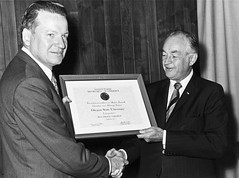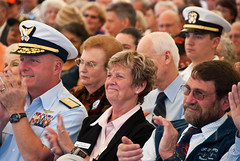Oregon Sea Grant, the coastal and marine research and education program based at Oregon State University (OSU), celebrates its fortieth anniversary September 17, and Governor John Kitzhaber has proclaimed the date “Oregon Sea Grant Day.”
(Read the proclamation – .pdf format)
The proclamation recognizes the program for forging a “dynamic partnership” with the Oregon University System, the State of Oregon, Oregon coastal communities, and the National Oceanic and Atmospheric Administration (NOAA) since September 1971.
“Oregon Sea Grant funds top-quality research with high relevance to society,” the proclamation reads, “as part of an integrated program of research, education, Extension, and public science communication.”
Many Oregonians come in contact with the program at the Hatfield Marine Science Center in Newport, through the public education and free-choice learning activities which Sea Grant leads. Over the last 40 years these programs have engaged more than 11 million visitors and hundreds of thousands of Oregon school children.
Still others are familiar with Sea Grant from contact with its OSU Extension faculty, many of them located in coastal communities. The program also produces publications, videos, and Web-based media on a wide range of ocean and coastal topics, from tsunamis to fisheries and from healthy ecosystems to the effects of climate change.
“Everything we do is intended to help Oregonians understand, conserve, and wisely use ocean and coastal resources,” said Stephen Brandt, Sea Grant director. “That mission has been a constant.”
OSU President Ed Ray acknowledged the Governor’s day, offering Brandt his congratulations “for this most appropriate recognition of such an important and accomplished program.”
Although Sea Grant had begun in Oregon in 1968, in 1971, when the program was officially designated a “college program” under NOAA, OSU President Robert MacVicar journeyed to Washington, D.C. to meet personally with federal officials, among them Robert Abel, then director of the national office of Sea Grant. Abel lauded Oregon Sea Grant for the “highest degree of effectiveness in its program.”
Oregon’s federal funding was the largest of the four programs designated in 1971 (others were in Washington, Texas, and Rhode Island.) Today Sea Grant programs are found in every coastal state; and Oregon’s is still widely considered one of the very top programs.





